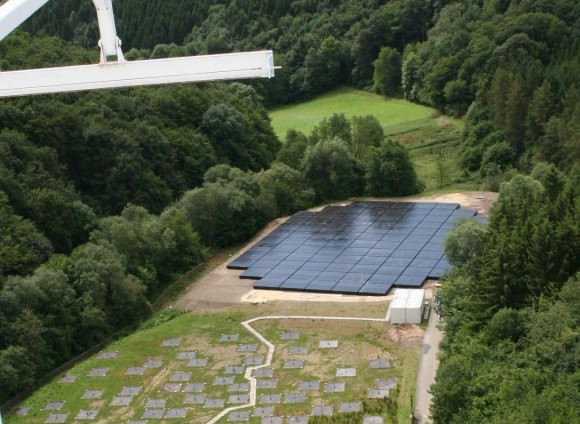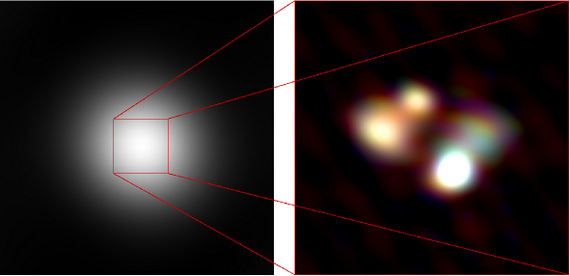[/caption]
Just eight of the eventual forty-four antenna stations for the LOw Frequency ARray (LOFAR) were combined to produce the first high-resolution image of a distant quasar at meter radio wavelengths. The first image shows fine details of the quasar 3C 196, a strong radio source several billion light years away, observed at wavelengths between 4 and 10 m. “We chose this object for the first tests, because we know its structure very well from observations at shorter wavelengths,” said Olaf Wucknitz from Bonn University. “The goal was not to find something new but to see the same or similar structures also at very long wavelengths to confirm that the new instrument really works. Without the German stations, we only saw a fuzzy blob, no sub-structure. Once we included the long baselines, all the details showed up.”
Five stations in the Netherlands were connected with three stations in Germany. To make detailed observations at such low frequencies, the telescopes have to be spaced far apart. When complete, the LOFAR array span across a large part of Europe.
Observations at wavelengths covered by LOFAR are not new. In fact, the pioneers of radio astronomy started their work in the same range. However, they were only able to produce very rough maps of the sky and to measure just the positions and intensities of objects.
“We are now returning to this long neglected wavelength range”, says Michael Garrett, general director of ASTRON, in The Netherlands, the institution that leads the international LOFAR project. “But this time we are able to see much fainter objects and, even more important, to image very fine details. This offers entirely new opportunities for astrophysical research.”
“The high resolution and sensitivity of LOFAR mean that we are really entering uncharted territory, and the analysis of the data was correspondingly intricate”, adds Olaf Wucknitz. “We had to develop completely new techniques. Nevertheless, producing the images went surprisingly smoothly in the end. The quality of the data is stunning.” The next step for Wucknitz is to use LOFAR to study so-called gravitational lenses, where the light from distant objects is distorted by large mass concentrations. High resolution is required to see the interesting structures of these objects. This research would be impossible without the international stations.

LOFAR will consist of at least 36 stations in the Netherlands and eight stations in Germany, France, the United Kingdom and Sweden. Currently 22 stations are operational and more are being set up. Each station consists of hundreds of dipole antennas that are connected electronically to form a huge radio telescope that will cover half of Europe. With the novel techniques introduced by LOFAR, it is no longer necessary to point the radio antennas at specific objects of interest. Instead it will be possible to observe several regions of the sky simultaneously.
The resolution of an array of radio telescopes depends directly on the separation between the telescopes. The larger these baselines are relative to the observed wavelength, the better the achieved resolution. Currently the German stations provide the first long baselines of the array and improve the resolution by a factor of ten over just using the Dutch stations. ASTRON officials say the imaging quality will improve significantly as more stations come online.
“We want to use LOFAR to search for signals from very early epochs of the Universe,, said Benedetta Ciardi from the Max-Planck-Institut für Astrophysik (MPA) in Garching. “Having a completely theoretical background myself, I never had thought that I would get excited over a radio image, but this result is really fascinating.”


What exactly am I seeing here? The excretion disk and plumes?
3C 196 is a FR II radio source, meaning that it has two radio-bright lobes (hotspots, where the AGN jets decelerate and dump their energy into the IGM), with (maybe) a central source (the AGN).
On top of that, 3C 196 has a barred spiral in the foreground (http://www.astr.ua.edu/keel/agn/3c196.html).
In 2006 a paper was published, on results od hi-res optical observations of this object: A jet-cloud interaction in the 3C 196 environment (http://arxiv.org/abs/astro-ph/0603591).
However, without a scale on the LOFAR image, it is impossible for us (readers of the UT story) to even guess which part of the hi-res LOFAR image corresponds to what 3C 196 feature.
On top of that, there’s nothing (yet) in arXiv!
Perhaps Nancy could contact MPIfA to get some clarification?
Oh yes. I worked recently at IRFU (Swedish Institute of Space Physics, Uppsala, which is involved with the Swedish LOFAR:
“LOIS is a project intiated [sic] and led by the Physics in Space programme [sic] of the Swedish Institute of Space Physics (IRF) in Uppsala.”
Seems like a good ROI investment – and lot of fun, as it is developed as we write.
I recall watching an Open University TV programme late one night, ten odd years ago, on BBC 2, which featured the early days of radio astronomy and how Jocelyn Bell Burnell and Antony Hewish discovered pulsars using nothing more sophisticated than “Washing Line” dipole antennas, as mentioned above.
The high-resolution LOFAR image of 3C196 very well matches radio maps of that quasar that were obtained at GHz frequencies during the last 20 years.
The great thing with LOFAR is that it can provide detailed radio images of any object in the sky over a range of frequencies, without having an antenna pointed at the source, and without having an antenna tracking the source.
NGC3314 (Bill Keel) has commented on this UT story, over in the Galaxy Zoo forum (http://www.galaxyzooforum.org/index.php?topic=277806.0).
He mentions a 1984 paper on this quasar (http://adsabs.harvard.edu/full/1984MNRAS.208..545L), where approximately the same four sources are seen in a 408 MHz map made by MERLIN. The scale is such that the resolved sources (which are hotspots?) are separated by ~6″.
GBendt,
Can you point to some of these GHz radio maps, available on the internet (and not behind a paywall)?
I contacted Olaf Wucknitz and he provided an extensive explanation. I just posted a new article about it: http://www.universetoday.com/2010/06/02/scientist-explains-new-lofar-image-of-quasar-3c196/